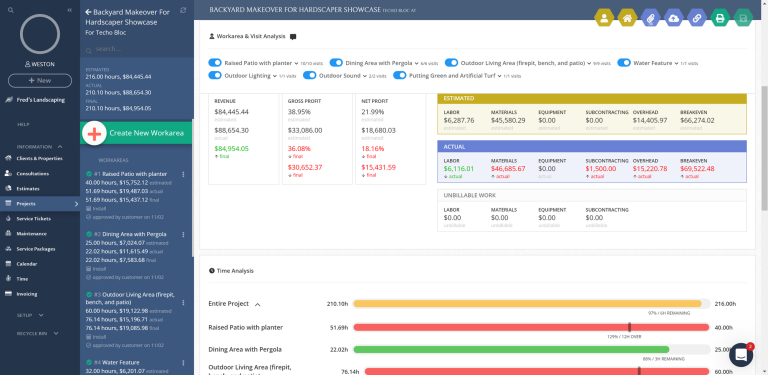How to Know If You Are On Track With Jobs

Recently I wrote a blog on “What is the point of software”, and in there I had 4 main points (one specifically about how to track your jobs):
- To know your numbers
- Streamline workflows and operations
- Get info out of the owner’s head, and into systems and processes
- Know where you’re going right, and where you’re going wrong
Since then I’ve been writing a deep dive into each of those.
How to know if you’re on track
Today, I’m doing a deep dive into the 4th point: How to know if you are on track with jobs.
Aka, how to know when you go right, and when you go wrong.
It goes without being said this is super important.
If you’ve ever run dry on cash in the bank and didn’t know what to change to fix it, you know what I mean. Not knowing is like driving blind. If you don’t know when you go wrong or when you go right, you have no feedback loop. You kind of just continue doing the status quo, nothing ever changes.
If this is how you operate, the first warning sign is when cash flow starts drying up and your checking account empties.
That’s a seriously tough spot to be in.
We want to build in warning signs long before that. We want to know in real time when things go sideways.
When things do go sideways, you could dig into your P&L. There’s a lot a P&L can do for you, but it can’t tell you where the leak is in most cases. It won’t tell you what you need to do differently. (Ok, well, unless you’re blowing cash on toys, a P&L will tell you that 😜)
But that’s usually not the case.
Usually, you’re getting up before the sun, working hard all week, and you just need this to work out. Need that reward. You don’t want to waste your sweat on the ground to just break even.
What you really need to know is much deeper than the P&L. You need to know not only which job went off the rails, you need to know what part of the job went sideways. And you need to know it in real-time, so you can react and respond!
The way to cast light on all this is to know.
To know means to track
To track means to clock in/out on every job. To track all materials (yep, even that couple tons of stone you grab from your pile at the shop, that generated no receipt).
Said more simply – track all time and expenses.
It’s the only way you’ll know. The only way to cast light.
But tracking is hard isn’t it?
Well… yes, it can be, if you do it all manually. But it doesn’t have to be manual. It can be one smooth seamless experience if you use SynkedUP. (shameless plug 😎)
But back to the principle, I’m talking about.
You can do all the hard work of budgeting, recovering overhead, and doing all that math in your proposals perfectly. But that’s only half the battle.
Granted, if you don’t get these numbers right, your profits are playing Russian roulette. But there’s more to this.
The other half of the battle is tracking the man hours, the materials, the tonnage of stone, those couple extra layers of pavers you picked up, everything.
Because if you get the quantities of materials and man hours in your estimate wrong, it doesn’t matter how flawless your math, markups, and overhead recovery is, you’ll still get it wrong. There are two ways to lose profits on a job.
- Get the math wrong (budgeting, overhead recovery, estimating)
- Get the quantities wrong (took longer than you figured, needed more stone than you thought)
And back to the tracking part, I was talking about, the only way you’ll know if you are getting #2 right or wrong is if you track.
Track man hours allocated to that job (not hard with an app, but a pain trying to do it manually)
Track all receipts (not hard, you may be doing this already)
And all materials you use from your shop. Aka stuff that doesn’t generate a receipt. (this is easy to miss, but SynkedUP tracks it beautifully and simply)
If you do this, you got the answers. You’ll know when things go right or wrong. And you can nip the issue in the bud, and avoid repeating the same mistakes all over again.
That’s what is called job costing.
This is what it looks like:

Granted, you can do this in a spreadsheet manually. It’s not hard to job cost… …Once you have the data (hours, receipts, inventory/bulk materials) to job cost with.
The hard part is tracking the data to plug into the spreadsheet.
Conclusion
And that’s what we set out to make easy in 2016 when we started building SynkedUP. And today, there are hundreds of companies all across North America that are reaping the benefits of knowing exactly where they go wrong or right.
In real-time.
Not 5 weeks later. When you finally got the info into your spreadsheet. By that time, when you ask the crew what went wrong and what could we have done better, they are on their 8th job since then and it’s really tough to remember reasons, cause and effect, and what we should change to avoid making the same mistake again.
Join the growing SynkedUP crew, and join the movement of entrepreneurs who are saying no to just breaking even, and instead, #thrivingnotsurviving.
- Paying off equipment.
- Paying guys better.
- Getting more time with family.
- Living better lives.
That’s our mission.
They know exactly where they stand and are locked and loaded, ready for 2023. 💪
If you want in the SynkedUP Crew, no better time than now. We’re running an offer we’ve never done before, 3 months of the PRO upgrade for free when you sign up before Dec 31 2022.
Just shoot me a reply to this email or text me: 814-383-1900.
Cheers,
Weston

